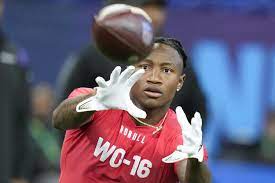INDIANAPOLIS (AP): NFL teams might have considered Zay Flowers a one-dimensional wide receiver a decade or two ago.
Today, the 5-foot-9, 182-pound former Boston College star understands he cannot rely solely on his 4.42-second speed to make plays. He must be a more complete player.
So Flowers spent last season and the past few weeks adding muscle, working on blocks and learning how to play multiple receiving spots in an effort to showcase his versatility when he came to Indianapolis for the league’s annual scouting combine.
“I’d say the game started off with bigger receivers that could block and take hits and over time, I’d say Tyreek Hill really changed it for smaller receivers,” Flowers said. “Being able to do what he does, being able to put the ball in his hands anywhere and score touchdowns has helped guys like me.”
It’s not just small guys like Hill and Flowers making moves that are changing draft boards, though.
NFL teams looking to find the next Ja’Marr Chase, Travis Kelce or Christian McCaffrey can choose from a variety of body types, playing styles, physical skills and developmental levels available this year.
Yes, with 69 of 319 combine invitations going to receivers or tight ends, this year’s draft promises to have something for everyone in an increasingly pass-happy league.
“What we’ve seen over the last few years is the dynamic — these guys might go higher than you have them rated because of the importance of the position,” Baltimore Ravens general manager Eric DeCosta said before talking about this year’s group. “I think it’s strong, it’s a good class. Hopefully we’re positioned to get a guy we like.”
Just how much do teams value pass-catchers? They’re being paid top dollar.
Fourteen receivers currently average $20 million or more annually, topped by Hill’s four-year deal at $30 million per year. Seven tight ends have annual average salaries of $13 million or more, and McCaffrey is the highest-paid running back at an average of nearly $16.1 million.
That’s forced some teams to bring in younger, cheaper talent through the draft, and what they’re finding are more rookies ready to make immediate impacts, as Chase demonstrated two years ago with the Cincinnati Bengals.
This year promises to be more of the same.
As offenses attempt to spread the field long and wide with jet sweeps and bubble screens and scheme to get tight ends and running backs matched up against linebackers, there are many options available.
Some analysts believe tight end Michael Mayer of Notre Dame could be the next Kelce despite his slower-than-expected 4.7-second 40-yard dash in Indy. Perhaps 264-pound Darnell Washington, a two-time national champion at Georgia who is still developing his receiving skills, will emerge as that guy. Or it could be Josh Whyle, the newest tight end prospect from Cincinnati — Kelce’s alma mater.
“We have a sign up in our room that says, ‘Through these halls walk the best tight ends in the country,’” Whyle said.
There’s an interesting mix of multi-position players, too.
Versatile running backs such as Tyjae Spears of Tulane, Chris Rodriguez Jr. of Kentucky and 5-foot-5 Deuce Vaughn of Kansas State have proved they can excel as runners, receivers or returners — something once considered a luxury.
Now, it’s an essential component for title-winning teams.
“Coach (John) Settle is always telling me, ’Hey, I made an all-Madden catch on a pass out of the backfield,” Rodriguez said, referring to his former college running backs coach. “I don’t even know what all-Madden is, but he told me it’s going to be really huge, especially at the next level. So that’s something I’ve been working on.”
The variety at receiver is intriguing.
Projected first-round picks range from the 6-foot-3, 208-pound Quentin Johnston of TCU to Flowers and from 2021 Biletnikoff Award winner Jordan Addison of Southern Cal, who caught 219 career passes, to Jaxon Smith-Njigba, who had 110 career catches and missed all but three of Ohio State’s games last season with a hamstring injury.
How they’ll rank is anybody’s guess, but as they jockey for position to be the first receiver chosen on April 27, the truth is teams will base their decisions on preference and need.
“We know as a receiver, you have to be a playmaker,” Bears coach Matt Eberflus said. “We saw it in the playoffs, we saw it in the Super Bowl. Those guys were making plays at critical moments and that’s what we need. So if we can add a critical piece like that in the draft, we’re going to do that.”
It could be Flowers, who has expanded not only his repertoire but the case to be made for being at the top of this receiving class.
“I’m not just a slot: 75% of my snaps were played outside,” he said. “I think I can move around and play any position they put me.”







